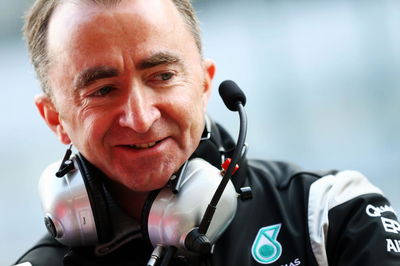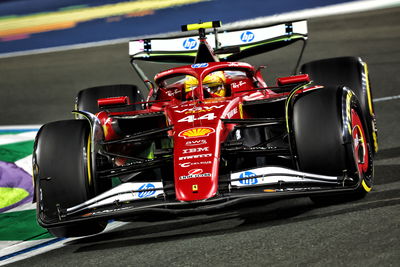REWIND: Paddy Lowe discusses his favourite F1 race

As Paddy Lowe exits Mercedes after four incredibly successful seasons as its Executive Director (Technical) for a likely return to Williams, read our exclusive interview with him from 2015 as he goes way back to 1992 to tell us all about his favourite race... a Williams race, no less
First published in July 2015
With a career in Formula One spanning almost thirty years, Mercedes' Executive Director (Technical), Paddy Lowe, has seen it all when it comes to drama, on-track action, championship deciders and classic races.
Unsurprisingly though for a man with a CV boasting senior engineering roles with Williams and McLaren as well as his current position with Mercedes, when asked for memories of his favourite race, Lowe concentrates on a race of great technical significance - featuring a starring role for an innovation which Lowe himself played a vital role in developing.
The 1991 Formula One season saw the beginning of a reversal in fortune, as Williams-Renault started to turn the tide against McLaren-Honda and re-establish themselves as the pre-eminent team in the sport. The Williams FW14 in the hands of Nigel Mansell ran Ayrton Senna close for the title, but fell short of preventing the Brazilian from claiming his third championship, and McLaren's fourth on the spin.
Behind the scenes though, the Williams technical department had been developing an innovation which they would unleash to devastating effect to dominate the 1992 season - starting at the South African Grand Prix in Kyalami. As Lowe explains, "I'd come to work for Williams at the beginning of their first generation of active suspension at the end of 1987 and racing it in 1988. We were really unprepared on every level to race something which for that era was so complex though."
"It wasn't even about the car itself, it was about the infrastructure in terms of people, technology, understanding, support - it was nowhere," continues Lowe. "We spent the next five years building that capability towards 1992 with the active suspension and traction control, whose first appearance was [Kyalami]. We spent five years building up to this point of playing our secret weapons - this was our moment."
 |
According to Lowe, it was clear from pre-season testing that Williams had developed something special - but beating McLaren was as much of a mental obstacle as it was a question of lap times. "As it turned out, the active suspension and the traction control were both worth about a second a lap from our winter testing," Lowe explains. "McLaren had been so dominant through that preceding period. We gave them a bit of a hard time in '91 but they still won it, so my whole career up to that point they were always winning... I couldn't imagine that you could beat McLaren."
Having not tested alongside McLaren during the winter, Williams still had no idea of their rivals' pace heading to South Africa. Come FP1 in Kyalami though, and Williams' and Lowe's thoughts quickly moved from imagining to dreaming. "You go into P1, and we're massively quicker than them and you think, 'there's something wrong, they're just sandbagging or something'. As the sessions went on you began to believe that 'maybe we've got something here'," Lowe recalls.
Come qualifying, and Nigel Mansell took pole position by seven tenths with the McLarens of Ayrton Senna and Gerhard Berger second and third. Mansell's teammate Riccardo Patrese was a distant fourth, 1.5 seconds down on the sister Williams. It laid down a marker for the season, with Mansell in particular benefitting from the FW14B's characteristics. As Lowe tells us, "Nigel had come to that race on absolutely top form. He loved the active car, it really played to his strengths. [The car] had this feature where as you lifted off you lost the balance quite a bit - so the more you stayed on the throttle the more the car worked. [Nigel]'s a driver with huge confidence... and the active car thrived on that confidence."
Despite Mansell's dominant qualifying performance, Lowe was taking nothing for granted on race day. "I remember being on the grid and this car was quite complex and I was the only one who knew all of the things that could go wrong - more than anyone else," Lowe recalls. "I was feeling physically sick thinking of what could go wrong as there were so many new things on the car which had never raced before."
"Active suspension was something which took quite a long time to arrive, it was the product of 5/6 years work whereas the traction control was something that was the product of 3 months work - one of those things that just come together really nicely and added as much lap time," Lowe continues.
"Renault were a bit unhappy with [the traction control] because they hadn't done any endurance work with [it], so Nigel switched off his traction control in the race as Renault didn't want us to run it. Riccardo was being threatened by Ayrton so whenever he was threatened we told him to put the traction control on and he would leave him behind to open up a gap - then the Renault guys would come out and say 'turn it off!'. So we'd turn it off again and Ayrton would catch up - that happened two or three times."
Mansell duly went on to win the race, cruising home to take the chequered flag by 24 seconds from Patrese. It would be the first of three consecutive 1-2 finishes to open the season, and the first of six overall during the year. Mansell would go on to win the opening five rounds and a total of nine races en route to becoming champion with 108 points - all records at the time and illustrations of the Williams FW14B's dominance.
 |
Mansell's win was memorable for many reasons, but Lowe reveals that a cheekily collected bonus memento offered an extra special significance. "I've actually got the champagne bottle from that race, which Nigel signed and wrote, 'First Win' on there," Lowe tells us. "I shouldn't really have had it as it was supposed to go to the mechanics... I felt a bit bad taking the bottle but I did sort of think, "that's mine, I earned that!"
Few would disagree as Lowe was one of the key men behind a quantum leap in performance, and it's little coincidence that McLaren in 1998 and Mercedes in 2014 also enjoyed similar jumps forward during Lowe's tenure. For Lowe, there are significant differences in the development race during the 1990s and today however.
"In those days we were far more resource limited," Lowe explains. "Now we are regulation limited, so if we find a gap in the regulations or a change is made we will exploit that right to the limit within days or weeks. We have all the knowledge, experience and technology... Back then there was a lot of technology in the aerospace industry that we weren't using. We were 20 years behind the times in terms of what was possible."
"You could come along and come up with an idea like active suspension, traction control or active steering, power brakes, automatic gears - and it wasn't about whether they were legal, they were all legal, it was about 'can I actually do that, and have I got the people, the capacity and the knowledge to implement that'," Lowe continues.
The systems that Lowe and Williams implemented in 1992 represented the pinnacle of technological evolution at the time. Not only was the Williams-Renault FW14B the outstanding class of the field throughout the 1992 season, but the success of that year instigated a period of dominance for the Grove outfit that well and truly knocked McLaren off their perch. The foundations of Williams' supremacy through the early 1990s were built on a mastery of the complex electronic systems that defined the era, and the 1992 South African Grand Prix was the first public demonstration of a technical weaponry so potent that all such devices would be outlawed by the Hockenheim Agreement barely 18 months later.
 |
By then Lowe was en route to McLaren and plotting another reversal of fortunes, but even involvement in further epochal benchmarks such as the McLaren MP4-13's demolition of the field at the 1998 Australian GP, or the first outing of the Mercedes W05 at the same circuit 16 years later can't displace the fond affections of Kyalami '92 - proving that nothing is ever as sweet as the first time.











